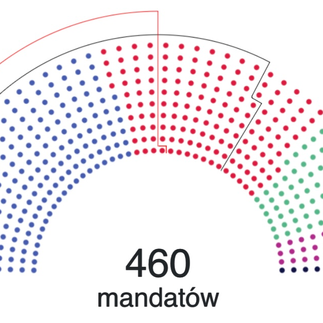Polish Election Shakes the Sejm: Kingmakers, New Faces, and a Grand Coalition
- Konrad Szuminski
- Oct 18, 2023
- 4 min read
Updated: May 23, 2024

The results are in, Poland’s electoral commission (PKW) confirms that the ruling Law and Justice Party (PiS) are the largest Party, having won 35,38% of the vote. The Civic Coalition (KO), led by Donald Tusk, came second with 30.7% of the vote. Thus, the results of the other three parties are crucial.
The centre-right coalition, The Third Way, won 14.40% and had a great night. This alliance consists of Poland 2050, led by Szymon Hołownia, and the Polish People’s Party (PSL), led by Władysław Kosiniak-Kamysz.
Further, the New Left (Nowa Lewica) won 8.61% and enjoyed great success, taking fourth place ahead of the far-right Confederation Party, which won 7.16%.
These Parties met the electoral threshold of 5% of the vote share (8% is required for coalitions).
The election saw a remarkable turnout of 74.4%, the highest since the fall of the Soviet Union. President Duda rightly commended the long queues of people going to the polls.
Amongst the youngest age group (18-29 year olds), the turnout was 68,8%, according to TVN (Poland’s most prominent independent broadcaster). This is an excellent result in an age of political apathy and disinterest among young people. I am very proud to be Polish and to have cast my first ballot on Sunday.
Now, how do the results shape up in the Polish Parliament (Sejm)?
Make-up of the Polish Sejm
Source - tvn24.pl (Translation - 231 mandates is minimum for the majority, 307 mandates are required for constitutional changes)
For ease of understanding, the light blue is PiS (194 mandates), the Red are KO (157 mandates), the Green is the Third Way (65 mandates), the Purple is the Nowa Lewica (26 mandates), and the Konfederacja are the dark navy blue/black (18 mandates).
PiS are 37 seats off a majority, having lost 41 mandates since the 2019 general election, where they won a majority with 235. KO has gained 23 mandates. Interestingly, the Third Way party PSL has gained 35 mandates, likely taking bites out of PiS’ missing 41. The Confederation has gained 8 mandates.
These results mean that the Opposition Parties, KO, the Third Way and the New Left, have between themselves 248 mandates, putting them in the substantial majority.
As of the afternoon of October 17th, Donald Tusk has appealed to Andrzej Duda to begin the process of bringing in a new Government, saying that the Opposition parties are in “constant contact” and are ready to “take power at any moment”. This suggests that a coalition agreement has been brokered.
A right-wing coalition seems unlikely and would not be enough
To add misery to PiS, the entirety of the Confederation Party’s campaign underlined their status as a dark horse in this election, as they pledged to “flip the coalition table upside down” for PiS and, if it came to it, KO. It would be political suicide if they were to go back on that and go into coalition with PiS.
And yet, even then, a right-wing coalition would not meet the evasive 231.
The Third Way are the Kingmakers
PSL, part of the Third Way coalition with Poland 2050, was part of Tusk’s Government (2007-2014). They are now the kingmakers as the third biggest Party, having 34 more mandates than they did in 2007, and thus, they can sit confidently across the table from KO and potentially PiS. However, a coalition with Law & Justice looks unlikely, given that PSL, Poland’s agrarian Party, lost much of their support from 2015 onwards to PiS.
The coalition is worth examining. On one side, you have a fresh new party, Poland 2050, led by Szymon Hołownia. It swings from centre left to centre right to accommodate support as a moderate party. Carbon neutrality by 2050 is a core mission, setting out a modern vision for the century where Poland moves with the West to develop a carbon-neutral economy of the future. On the other hand, you have an established party in the PSL (Polish People’s Party), led by Władysław Kosiniak-Kamysz, a centrally agrarian party. Under Kamysz, PSL have swung a more “third way” vision from agrarian socialism in the late 20th century to a “moderately centrist” party.
Although the third way is the talk of the town, the New Left are also critical for the coalition.
The New Left could be the face of a more liberal Polish society.
Having been born out of the remnants of the SLD, it is the most powerful left-wing Party in Poland, with Robert Biedron, the first openly gay man to enter the Sejm (Parliament), as co-leader of the New Left, alongside Włodzimierz Czarzasty.
If the New Left becomes a part of a grand coalition, it will turn a kinder face towards Poland’s LGBT community and a broader spectrum of views from the otherwise centrist Polish opposition.
It is essential to note that in the run-up to the election, these parties have had trouble collaborating, and the task of forming a grand coalition that lasts till the next general election is daunting.
However, Tusk’s video indicates that an agreement has been brokered.
Therefore, the ball is now in the President’s court. As President, it is his constitutional duty to acknowledge a new Government. However, there have been suggestions that the President, belonging to the PiS Party, may try to disrupt and draw out the formation of a Government to keep PiS in power.
I hope that such a constitutional crisis does not take place.
Nevertheless, the coming days are worth watching, as the formation of the next Government should commence.
Image: The Prime Minister of the Republic of Poland
.png)

